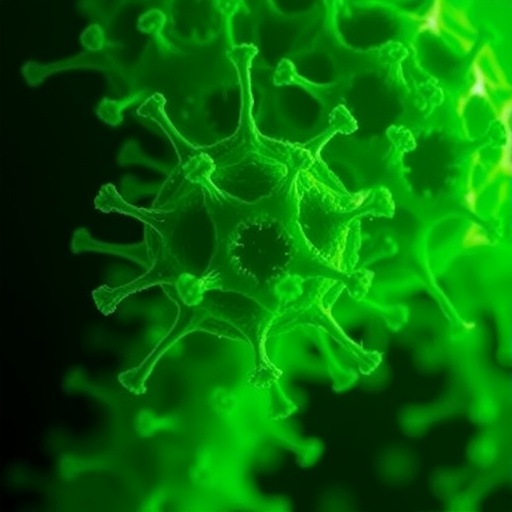In a groundbreaking study that explores the intersection of natural compounds and microbial behavior, researchers have made significant strides in understanding how plant-derived O-methylated flavonoids can disrupt the communication systems of Pseudomonas aeruginosa, a notorious opportunistic pathogen. This bacterium is well-documented for its ability to cause severe infections, particularly in immunocompromised individuals, and is often found in hospitals. The study highlights how these specific flavonoids can hinder not only the quorum sensing mechanisms of this pathogen but also its ability to form biofilms, which are protective structures that bacteria use to shield themselves from the immune response and antibiotic treatments.
Quorum sensing is a crucial form of communication employed by bacteria, allowing them to coordinate their collective behavior in response to population density and environmental cues. In Pseudomonas aeruginosa, this process enables the bacteria to launch coordinated attacks that increase their virulence. The researchers beginning their investigation sought to determine whether certain flavonoids could interfere with this sophisticated communication pathway. Their findings are poised to offer new avenues for treating infections that are traditionally challenging to manage, splitting the attention between enhancing host defenses and targeting bacterial communication strategies.
The O-methylated flavonoids studied derive from various plants, showcasing the potential power of botanical chemistry in addressing modern medical challenges. These compounds are known for their antioxidant properties and have been investigated for their anti-inflammatory, anticancer, and antimicrobial effects. The current study, however, shines a spotlight solely on their capacity to interfere with bacterial communication. By meticulously performing a series of experiments, the researchers demonstrated that certain O-methylated flavonoids could significantly reduce the production of virulence factors, which are critical in the pathogenesis of Pseudomonas aeruginosa.
The team utilized advanced methodologies including high-performance liquid chromatography (HPLC) and mass spectrometry to analyze the effects of the flavonoids on bacterial cultures. Through this rigorous experimentation, they observed a marked decrease in biofilm biomass, which is a telling sign of the bacteria’s ability to establish chronic infections. Furthermore, the treatment with these O-methylated flavonoids appeared to prevent the bacteria from reaching the necessary quorum sensing threshold, effectively impairing their ability to communicate and act as a unified entity.
These findings carry profound implications for the medical community, particularly for treatments of Pseudomonas aeruginosa-related infections. The resistance of this bacterium to multiple antibiotics is a pressing concern in healthcare settings worldwide. As antibiotic resistance continues to rise, the search for novel therapeutic strategies becomes even more critical. The research indicates that targeting the communication pathways of this pathogen could serve as a complementary strategy to traditional antimicrobial therapies, potentially leading to more effective treatment regimens and reduced reliance on antibiotics.
The safety profile of these plant-derived compounds also deserves attention. Given their natural origin, O-methylated flavonoids may present fewer side-effects compared to synthetic drugs. This poses an exciting possibility for the development of new treatments that harness the strengths of both plant-based and synthetic pharmacology. As the study progresses, further exploration into the molecular mechanisms behind the interaction between flavonoids and bacterial signaling pathways is anticipated to reveal even deeper insights.
Moreover, the environmental sustainability of using natural compounds such as these flavonoids stands in stark contrast to the extensive manufacturing processes often found in synthetic drug production. This aligns with a growing ethos in medicine that prioritizes not only patient outcomes but also ecological considerations. The plant-based approach emphasizes the importance of research into renewable, organic resources that can yield new therapeutic options while being kinder to the planet.
As the scientific community digests these promising findings, collaboration between microbiologists, pharmacologists, and botanists may catalyze a new wave of studies focused on phytochemicals in combating resistant pathogens. The urgency of addressing antibiotic resistance cannot be overstated, and this research could inspire initiatives to harness the protective qualities of natural products in a more systematic way.
In conclusion, the disruption of quorum sensing and biofilm formation by O-methylated flavonoids presents a compelling alternative in the fight against Pseudomonas aeruginosa infections. Further research will undoubtedly be needed to refine these findings into viable treatment strategies, encompassing both in vitro studies and clinical trials to understand dosage, effectiveness, and potential interactions in human patients. The convergence of natural product chemistry and microbiology may well yield solutions that have eluded healthcare for years, indicating that nature still holds answers to some of today’s most pressing medical challenges.
As we anticipate the next steps following this discovery, the message is clear: by exploring natural solutions and integrating them into our arsenal against resistant bacteria, we stand to redefine the landscape of infectious disease treatment. The efficacy of O-methylated flavonoids against Pseudomonas aeruginosa offers a glimpse into a future where plants may help heal what once seemed unmanageable by human-made drugs alone.
Subject of Research: Disruption of quorum sensing and biofilm formation in Pseudomonas aeruginosa by plant-based O-methylated flavonoids.
Article Title: Disruption of quorum sensing and biofilm formation in Pseudomonas aeruginosa by plant-based O-methylated flavonoids.
Article References:
Prabhakaran, M., Prabakaran, M., Kanagaraja, A. et al. Disruption of quorum sensing and biofilm formation in Pseudomonas aeruginosa by plant-based O-methylated flavonoids.
Int Microbiol (2025). https://doi.org/10.1007/s10123-025-00726-8
Image Credits: AI Generated
DOI: https://doi.org/10.1007/s10123-025-00726-8
Keywords: O-methylated flavonoids, Pseudomonas aeruginosa, quorum sensing, biofilm formation, antimicrobial resistance, plant-based compounds.




